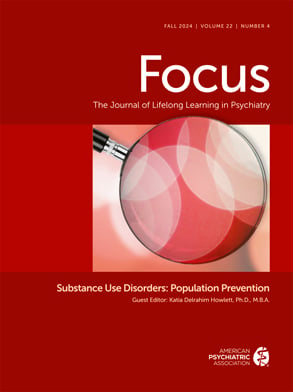My patient is a 31-year-old woman with a diagnosis of major depressive disorder (MDD). She has had a good response to a selective serotonin reuptake inhibitor (SSRI), which she has been taking for 8 months, and she now wants to stop taking it because she doesn’t like the idea of being on long-term medication. I am concerned because this is her second episode of MDD. Her first was 6 years ago, and it also responded to an SSRI. She went off the medication after 1 year and did not have a recurrence until this episode. What do you recommend?
Response from Michael Gitlin, M.D., Geffen School of Medicine at UCLA, Los Angeles, California:
This issue comes up regularly in clinical practice. The three core questions in addressing it are: What is the risk of recurrence? What is the likelihood of successful prevention of recurrence with antidepressants? And how does one compare the risk-benefit ratio of treatment versus nontreatment?
In evaluating the risk of recurrence in MDD, some generalizations can be made that apply to all patients, and some predictors of risk inform the decision for an individual patient. Although earlier data suggested that half of patients with unipolar depression may have only one episode in their lifetime, more recent prospective studies indicate much higher recurrence rates. For example, the National Institute of Mental Health’s Collaborative Depression Study found a 15-year recurrence rate of 87%. However, this estimate included all patients enrolled in the study—those with numerous prior episodes as well as those with relatively few. Predictors of recurrence from a variety of studies include early onset of illness (before age 21), later onset of illness (after age 60), multiple prior depressive episodes, long duration of individual episodes, the presence of interepisode dysthymia (double depression), and incomplete resolution of the previous depressive episode. Of these predictors, the most important is the number of prior episodes. With each subsequent depressive episode, the likelihood of another episode in the future increases.
Another factor in evaluating the risk of recurrence is whether the depression was triggered by life events. The evidence shows that depressive episodes are more likely to occur after a negative life event. For some patients, depressive episodes emerge only after such events, whereas for others, depressive episodes seem to emerge spontaneously; still others have a mixture of triggered and spontaneous depressions.
This patient is 31 years old, and the onset of her depression was at age 25. She has had two lifetime episodes, with apparently complete resolution of both. Between episodes, she was euthymic for 5 years. This suggests a history of recurrence, which is a risk factor for future recurrence, but her clinical signs and history are not consistent with a highly recurrent depressive disorder. We do not know whether either of this patient’s episodes was preceded by a major life stressor. Although no studies have examined this issue, logic would suggest that patients whose depressive episodes tend to be unrelated to life events are better candidates for long-term prophylaxis.
Multiple studies have demonstrated conclusively that all antidepressants effectively prevent recurrences. However, the vast majority of these studies have lasted only 6 to 18 months. In the only study that continued beyond 2 years, imipramine was clearly effective in preventing recurrence in a group of patients with recurrent depression (median of four prior episodes) for 3 years. A subgroup was followed for an additional 2 years, during which time participants who had been switched to placebo at the 3-year mark were significantly more likely to relapse than those who continued taking imipramine. Thus, the efficacy of imipramine (and presumably of other antidepressants) probably extends to at least 3 years and possibly 5 years.
However, this patient’s two episodes were separated by more than 5 years. Because no data are available on the efficacy of antidepressants in preventing recurrence in patients whose episodes may be of a relatively long-cycling type, the clinician must rely on common sense. A variety of factors may be considered in addition to those noted above in deciding whether long-term preventive treatment is appropriate: How severe are the depressive episodes? The more severe the episodes, the more reasonable it is to treat prophylactically. How responsive have past episodes been to treatment? The more responsive the past depressive episodes have been, the more reasonable it is to consider not treating preventively. How quickly do the episodes emerge? That is, has there been time to intervene before the episode becomes too severe and too damaging? The quicker the episode emerges, the less time the patient and the psychiatrist have to intervene before the episode becomes too severe. Does the patient have insight into the early symptoms of depression, thereby allowing her to call her psychiatrist and promptly institute acute treatment? How well does the patient tolerate the antidepressant that has worked acutely? Naturally, patients are more likely to consider long-term treatment with an antidepressant that both is effective and imposes a minimal side effect burden.
Given these considerations and the information we have about this patient, the typical course for the clinician would be to discuss and review with the patient the advantages and disadvantages of long-term maintenance treatment. For this patient, long-term treatment would be the conservative course. I would guess that most individuals with this patient’s history would opt for tapering the antidepressant and being followed without medication. Given the brief presentation we received at the outset, either option would be reasonable after thoughtful deliberation between patient and psychiatrist.

